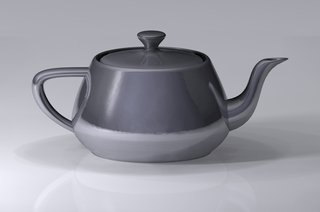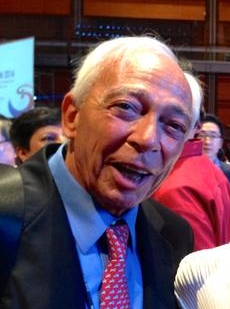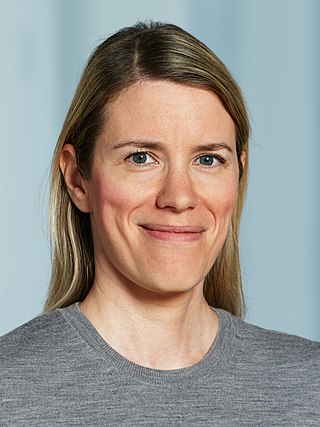Related Research Articles

Mesh generation is the practice of creating a mesh, a subdivision of a continuous geometric space into discrete geometric and topological cells. Often these cells form a simplicial complex. Usually the cells partition the geometric input domain. Mesh cells are used as discrete local approximations of the larger domain. Meshes are created by computer algorithms, often with human guidance through a GUI, depending on the complexity of the domain and the type of mesh desired. A typical goal is to create a mesh that accurately captures the input domain geometry, with high-quality (well-shaped) cells, and without so many cells as to make subsequent calculations intractable. The mesh should also be fine in areas that are important for the subsequent calculations.
HyperFun is a programming language and software used to create, visualize, and fabricate volumetric 3D and higher-dimensional models.

Computer graphics is a sub-field of computer science which studies methods for digitally synthesizing and manipulating visual content. Although the term often refers to the study of three-dimensional computer graphics, it also encompasses two-dimensional graphics and image processing.

Geometrical design (GD) is a branch of computational geometry. It deals with the construction and representation of free-form curves, surfaces, or volumes and is closely related to geometric modeling. Core problems are curve and surface modelling and representation. GD studies especially the construction and manipulation of curves and surfaces given by a set of points using polynomial, rational, piecewise polynomial, or piecewise rational methods. The most important instruments here are parametric curves and parametric surfaces, such as Bézier curves, spline curves and surfaces. An important non-parametric approach is the level-set method.
Chandrajit Bajaj is an American computer scientist. He is a Professor of Computer science at the University of Texas at Austin holding the Computational Applied Mathematics Chair in Visualization and is the director of the Computational Visualization Center, in the Institute for Computational Engineering and Sciences (ICES).

A Reeb graph is a mathematical object reflecting the evolution of the level sets of a real-valued function on a manifold. According to a similar concept was introduced by G.M. Adelson-Velskii and A.S. Kronrod and applied to analysis of Hilbert's thirteenth problem. Proposed by G. Reeb as a tool in Morse theory, Reeb graphs are the natural tool to study multivalued functional relationships between 2D scalar fields , , and arising from the conditions and , because these relationships are single-valued when restricted to a region associated with an individual edge of the Reeb graph. This general principle was first used to study neutral surfaces in oceanography.
Symposium on Geometry Processing (SGP) is an annual symposium hosted by the European Association For Computer Graphics (Eurographics). The goal of the symposium is to present and discuss new research ideas and results in geometry processing. The conference is geared toward the discussion of mathematical foundations and practical algorithms for the processing of complex geometric data sets, ranging from acquisition and editing all the way to animation, transmission and display. As such, it draws on many disciplines spanning pure and applied mathematics, computer science, and engineering. The proceedings of SGP appear as a special issue of the Computer Graphics Forum, the International Journal of the Eurographics Association. Since 2011, SGP has held a two-day "graduate school" preceding the conference, typically composed of workshop-style courses from subfield experts.
Hans-Peter Seidel is a computer graphics researcher at the Max Planck Institute for Computer Science and Saarland University.

Demetri Terzopoulos is an Academy Award winning Greek-Canadian-American computer scientist, university professor, author, and entrepreneur. He is best known for pioneering the physics-based approach to computer graphics and vision that has helped unify these two fields, and for introducing Deformable Models, among them the seminal Active Contour Models, to graphics, vision, medical imaging, and other domains; he is also known for his artificial life research on realistic animal and human modeling and simulation, encompassing musculoskeletal biomechanics, neuromuscular and neuro-sensorimotor control, and artificial intelligence. He has been a professor of computer science, electrical and computer engineering, and mathematics, and has taught courses in computer graphics, computer vision, scientific computing, and artificial intelligence/life at three universities. He is currently a Distinguished Professor and Chancellor's Professor of Computer Science in the Henry Samueli School of Engineering and Applied Science at the University of California, Los Angeles, where he directs the UCLA Computer Graphics & Vision Laboratory.

José Luis Moreira da Encarnação is a Portuguese computer scientist, Professor Emeritus at the Department of Computer Science of the Technische Universität Darmstadt in Germany and a senior technology and innovation advisor to governments, multinational companies, research institutions and organizations, and foundations. He is involved in the development of research agendas and innovation strategies for socio-economic development with a focus on emerging economies. He is also a member of the Topical Network Information and Communication Technology (ICT) and ICT-related activities of the German National Academy of Science and Engineering (acatech) and the German Berlin-Brandenburg Academy of Sciences and Humanities (BBAW). He is an elected member of the ACM SIGGRAPH Academy (USA).

Franco Brezzi is an Italian mathematician.

Annalisa Buffa is an Italian mathematician, specializing in numerical analysis and partial differential equations (PDE). She is a professor of mathematics at EPFL and holds the Chair of Numerical Modeling and Simulation.

Luiz Carlos Pacheco Rodrigues Velho is a Brazilian applied mathematician working primarily on computer graphics and computer vision. He is a full researcher and professor at Instituto Nacional de Matemática Pura e Aplicada (IMPA) and leading scientist of VISGRAF, laboratory that conducts researches in the field of modeling, rendering, imaging, and animation.
Leila De Floriani is an American-Italian computer scientist and a professor at the University of Maryland at College Park. She was formerly a professor at the University of Genova (Italy). She was the 2020 IEEE Computer Society President and the Editor in Chief of the IEEE Transactions on Visualization and Computer Graphics from 2015 to 2018.
Shape Modeling International (SMI), also known as International Conference on Shape Modeling and Applications is an annual symposium whose goal is to promote the dissemination of new mathematical theories and novel computational techniques for modeling, simulating, and processing digital shape representations. Initiated in 1997 by Tosyiasu L. Kunii and Bianca Falcidieno, the symposium became an annual event in 2001 after its merge with the Eurographics / ACM SIGGRAPH Workshop on Implicit Surfaces. The venue of the symposium rotates in turn among Asia, Europe and America.
Designers have used computers for calculations since their invention. Digital computers were used in power system analysis or optimization as early as proto-"Whirlwind" in 1949. Circuit design theory or power network methodology was algebraic, symbolic, and often vector-based.

Olga Sorkine-Hornung is a professor of Computer Science at ETH Zurich working in the fields of computer graphics, geometric modeling and geometry processing. She has received multiple awards, including the ACM SIGGRAPH Significant New Researcher Award in 2011.
Alla Sheffer is a Canadian researcher in computer graphics, geometric modeling, geometry processing, and mesh generation, particularly known for her research on mesh parameterization and angle-based flattening. She is currently a professor of computer science at the University of British Columbia.
Ilaria Perugia is an Italian applied mathematician and numerical analyst whose research concerns numerical methods for partial differential equations, especially Galerkin methods. She works at the University of Vienna in Austria as Professor of the Numerics of Partial Differential Equations.
References
- 1 2 Eurographics Medal 2019: Bianca Falcidieno, Eurographics, retrieved 2023-01-12
- 1 2 3 Bianca Falcidieno, IMATI, retrieved 2023-01-12
- 1 2 3 Wyvill, Brian; Falcidieno, Bianca (June 2022), "A conversation with Bianca Falcidieno: SMI 2021 Tosiyasu Kunii Achievement Award winner", Computers & Graphics, 105: A4–A8, doi:10.1016/j.cag.2022.05.011, S2CID 249211808